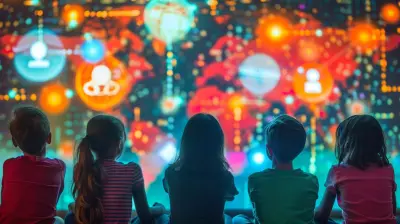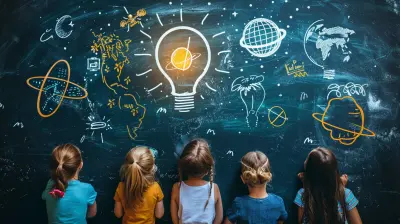Real-World Problem Solving: Bridging the Gap Between Theory and Practice
1 July 2025
Let’s be honest — we’ve all been there. Sitting in a classroom or reading through a textbook thinking, “When am I ever going to use this in real life?” Sound familiar? You’re not alone. One of the biggest challenges in education today is helping students connect what they learn (theory) with what they’ll actually do out in the real world (practice). That’s where real-world problem solving comes into play.
In this article, we're taking a deep dive into how we can bridge the gap between theory and practice through practical application, creative learning strategies, and real-world exposure. Whether you’re a student, an educator, or someone just curious about making education more relevant, stick around — there's something here for you.
Why the Gap Exists: Theory Vs. Practice
Let’s start at the beginning. Why is there even a gap?Theory is like the instruction manual to a device — it tells you how things should work in a perfect world. Practice, on the other hand, is like actually using that device when it's covered in fingerprints, has outdated software, and is running out of battery. Welcome to the real world.
In academic settings, we often focus on ideal models, formulas, and frameworks. They’re neat, tidy, and predictable. But real-world problems? Messy, unpredictable, and full of variables that didn’t show up in the textbook.
Take economics for example. You might study supply and demand curves, understand inflation, and memorize fiscal policies. But walk into a real business or government scenario and suddenly emotions, politics, culture, and random world events throw a wrench into the clean system you learned.
So how do we fix this disconnect?
Making Learning Stick: The Power of Real-World Problem Solving
Here’s the thing — we remember what we do, not just what we’re told. That’s why project-based learning, internships, and simulations are blowing up in popularity. They aren’t just flashy extras; they’re essential tools for bridging that theory-practice gap.Learning by Doing
Let’s break this down. Imagine you’re learning about environmental science. Sure, reading about climate change is one thing. But what if instead, you teamed up with your peers to conduct a local water quality analysis? Suddenly, you’re not just reading data — you’re collecting it, analyzing it, and presenting it to your community. You’re making a difference. That’s when learning really sticks.Case Studies and Simulations
Ever wonder why business schools love case studies? It’s because they drop students into real dilemmas faced by actual companies. You’re not just solving a hypothetical problem — you’re stepping into the shoes of someone who had to make a tough call. And simulations? Whether it’s a mock trial, a stock market game, or a medical emergency scenario, they prep you for the complexity of real-life decision-making.
The Role of Educators: Teaching Beyond the Textbook
Let’s give some props to the educators out there. Their job isn’t just to teach content — it’s to create thinkers. And one of the best ways to do that? Integrate real-world experiences into the curriculum.Bring in Outside Voices
Guest speakers, industry professionals, and community leaders can breathe life into classroom content. Imagine learning about journalism not from a textbook, but from a Pulitzer-winning reporter who’s been in war zones. That’s powerful stuff.Encourage Interdisciplinary Projects
Real problems don’t come neatly wrapped in subject-specific packages. So why should learning be any different? A project on urban planning might involve math (budgeting), science (environmental impact), and civics (policy implications). When students see how subjects intersect in real life, that’s when the light bulbs go off.
For Students: How to Apply What You Learn
Okay, students — it’s your turn. You might be thinking, “Cool, but how do I make what I’m learning more practical?” Great question. Here are some hands-on strategies.Volunteer or Intern
Whether you’re shadowing a nurse, helping with a school fundraiser, or building a website for a local charity, every bit of real-world experience counts. These situations force you to adapt, problem-solve, and communicate — skills books just can’t fully teach.Start a Side Project
Have a passion? Turn it into a project! Whether it’s coding a mobile app, writing a blog, or launching a campus sustainability campaign, the key is to build something. You’ll hit roadblocks — and that’s perfect. That’s where the learning happens.Ask the Right Questions
Whenever you learn something new, ask yourself: “Where would this show up in real life?” or “How could I use this to solve a real problem?” Keep your brain looking for connections, and suddenly, theory doesn’t feel so distant.Real-World Problem-Solving Skills That Matter
So, what kind of skills do you actually need to solve real-world problems? Spoiler alert: It’s not just about having the right answer — it’s about knowing how to think.Critical Thinking
The world doesn’t hand you multiple-choice questions. That’s why critical thinking is gold. You need to be able to analyze information, question assumptions, weigh evidence, and make smart decisions.Communication
Got a brilliant idea? Great. Now you need to explain it, pitch it, and maybe even defend it. Whether it’s writing reports, giving presentations, or collaborating with others, communication is key.Adaptability
Things rarely go as planned. You’ve got to pivot, improvise, and stay cool under pressure. That’s why flexibility and emotional resilience are becoming just as important as technical skills.Schools That Are Doing It Right
Some schools and programs are already crushing it when it comes to integrating real-world problem solving into education.STEM and Maker Spaces
Many schools now have maker labs where students are encouraged to build, tinker, and prototype solutions to real challenges. Think robotics competitions, environmental engineering projects, or app development camps.Project-Based Learning Programs
Programs like High Tech High or the International Baccalaureate encourage deep, project-driven learning that’s rooted in real-world issues. Students graduate not just as test-takers, but as thinkers, creators, and problem-solvers.The Role of Technology
Let’s not forget the tech.Virtual Reality and Augmented Reality
Imagine exploring the inside of a cell in 3D or walking through historical battlefields — with VR, students can experience the "real world" in ways that were never possible before.Online Collaboration Tools
Tools like Google Workspace, Slack, or Trello can introduce students to the way teams actually collaborate in the workplace. It’s not just about doing the work — it’s about doing it together.AI and Data Analysis Tools
Yep, even AI is part of the equation. Learn to work with it, not against it. There are a ton of tools out there that help students analyze data, generate ideas, and test hypotheses — just like professionals do.Life After School: Why It All Matters
So maybe you’re wondering — does all this really pay off?Absolutely. Employers aren’t just looking for degrees; they’re looking for doers. People who can hit the ground running, think critically, work well with others, and solve problems that don’t come with a cheat sheet. Real-world problem solving doesn’t just make education better — it makes you better prepared for life.
Final Thoughts: Let’s Blur the Lines
At the end of the day, we don’t need to throw out the textbooks. We just need to make them the starting point, not the finish line.Education shouldn’t be a bubble — it should be a launchpad into the world. When we start mixing theory with real-world grit, magic happens. Students don’t just learn — they transform. They become engaged, curious, and empowered to tackle the big, messy problems waiting outside the classroom door.
So, whether you’re a student tired of asking “Why does this matter?” or an educator looking to bring learning to life — remember this: bridging the gap between theory and practice is not just possible. It’s necessary.
And it starts with one question: “How can we make this real?
all images in this post were generated using AI tools
Category:
Problem SolvingAuthor:

Monica O`Neal
Discussion
rate this article
2 comments
Angela Schultz
Great insights on applying theory to real-world challenges!
October 8, 2025 at 2:21 AM

Monica O`Neal
Thank you! I'm glad you found it insightful!
Rex McHugh
Theory is only as good as its application. Let's stop talking and start tackling real-world problems head-on with actionable solutions.
July 13, 2025 at 11:24 AM

Monica O`Neal
Absolutely agree! Bridging theory and practice is essential for effective problem-solving. Let's focus on practical solutions that can make a tangible impact.


